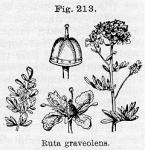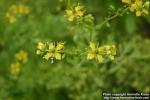
 Related entries: Oleum Rutae.—Oil of Rue
Related entries: Oleum Rutae.—Oil of Rue
The leaves and unripe fruit of Ruta graveolens, Linné.
Nat. Ord.—Rutaceae.
COMMON NAME: Garden rue.
ILLUSTRATION: Bentley and Trimen, Med. Plants, 44.
Botanical Source.—Rue is a glaucous, hairless, erect, suffruticose, perennial plant, with branching stems, 2 or 3 feet in height, woody below, with a grayish, rough bark; herbaceous and smooth above. The leaves are alternate, 2 and 3-pinnately divided; leaflets sessile, oblong, obtuse, dotted, glaucous, or bluish-green, 6 to 10 lines long, by 2 to 4 wide; terminal ones obovate-cuneate. The flowers are yellow, or pale greenish-yellow, in terminal, corymbose racemes; peduncles subdividing. Petals 4, yellow, unguiculate, concave, wavy, and a little irregularly toothed. Stamens 8, longer than the petals; filaments subulate; anthers ovate, obtuse, and yellow. Styles 4, distinct at the base, where they spring from the inner angle of the carpels above the common axis; united upward into a single pistil, which is attenuated toward the apex; stigma 4-furrowed. Carpels terminal, leafless, trichotomous, and cymose. The fruit is a roundish capsule, warted, and 4-lobed, each lobe opening into 2 valves. (L.—W.). It is remarkable that the anthers move in turns to the pistillum, and after having shed their pollen retire.
History, Description, and Chemical Composition.—Rue is a well-known evergreen, half-shrubby plant, common to southern Europe, and introduced into this country as a garden plant. It flowers in July and August. The whole plant has a strong, heavy, unpleasant smell, and a bitter, acrid, pungent taste, which is due to its volatile oil. The leaves are the parts used, and, when fresh, are said to irritate and even vesicate the surface to which they are applied. They should be gathered when the seed-vessels are welt developed, yet still green; the seed-vessels of the unripe fruit are covered with large oil vesicles, and may likewise be used for medicinal purposes. Rue yields its properties to boiling water in infusion, but alcohol is its best solvent. The plant loses much of its activity by drying. Its chief constituents are volatile oil (see Oleum Rutae), coumarin, the crystallizable, yellow glucosid, rutin (rutic acid), and a volatile alkaloid (Dragendorff's Heilpflanzen, 1898, p. 351).
Rutin (C42H50O25) was discovered, in 1842, by Weiss, in the leaves of the garden rue, and also occurs in the flower-buds (capers) of Capparis spinosa, Linné, Sophora japonica, Linné, and other plants. Boiling with diluted acids converts it into quercetin (1 molecule) and isodulcite (3 molecules). (For further details, see Husemann and Hilger, Pflanzenstoffe, p. 830; and Watt's Dictionary of Chemistry, Vol. IV, 1894, p. 419.)
Action, Medical Uses, and Dosage.—Rue is emmenagogue, ecbolic, anthelmintic, and antispasmodic. In large doses it seems to be a narcotico-acrid poison. It is asserted to cause abortion, and such effect is accompanied with inflammation of the stomach and bowels, with cerebral disturbance. Among the symptoms are retching and vomiting, violent pain in the stomach, headache, cerebral oppression and fullness, heat flushes, uncertain locomotion, somnolence, prostration, pulse feeble, at first rapid, then slow, coldness and twitching of the extremities, and frequent desire to pass urine, which is strongly impregnated with the peculiar odor of rue. Its action is chiefly directed upon the uterus, and is capable of exciting menorrhagia, inflammation, and miscarriage. It has been successfully used in flatulent colic, hysteria, some nervous complaints, epilepsy, and as an excellent vermifuge. Rue is a stimulant to the genito-urinary tract, and, in small doses, might prove a remedy in atonic conditions of these parts. Owing to its affinity for the nervous system, it relieves irritation and pain when administered in small amounts. It deserves study; and from 1 to 10 drops of the strong tincture (fresh herb, ℥viii to alcohol, 98 per cent, Oj) may be given, well diluted with water, at a single dose. Dose of the leaves, from 10 to 20 grains; of the decoction, from 1 to 4 fluid ounces, of the oil, from 2 to 6 drops.

